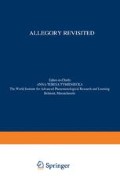Abstract
The idea that narrative occurs when a “text” provokes the reader to construct a “story” is a familiar and an established notion. At its simplest, the story, which is the abstracted sequence of events, renders the events into chronological order, while the text, which is a written or spoken discourse, presents the events out of chronological order. Traditionally, the “sense” that a story makes, its intelligibility, has been discussed in terms of plot (the intelligible shape of the action), character (for example, “she is the kind of character who would do such a thing, or respond in such a way), and theme (“what the story means is ...”). The production of meaning involves a complex interaction between text and the reader’s interpretive strategies.
Access this chapter
Tax calculation will be finalised at checkout
Purchases are for personal use only
Preview
Unable to display preview. Download preview PDF.
References
Bal, Mieke, Narratology: Introduction to the Theory of Narrative, trans. Christine von Boheemen (Toronto: University of Toronto Press, 1985).
Barthes, Roland, ‘Introduction to the Structural Analysis of Narratives’, Image-Music-Text, ed. and trans. Stephen Heath (New York: Noonday, 1977), pp. 79–124.
—, The Pleasure of the Text, trans. Richard Miller (NY: Hill, 1975).
Berger, Peter L., The Sacred Canopy: Elements of a Sociological Theory of Religion (Garden City, NY: Anchor-Doubleday, 1969).
Bruns, Gerald, ‘Introduction’, Theory of Prose by Victor Shklovsky, trans. Benjamin Sher (Elmwood Park, IL: Dalky Archive Press, 1990).
Chatman, Seymour, Story and Discourse: Narrative Structure in Fiction and Film (Ithaca: Cornell University Press, 1978).
Cohn, Dorrit, ‘signposts of Fictionality: A Narrative Perspective’, Poetics Today 11.4 (Winter 1990): 775–804.
Forster, E. M., Aspects of the Novel, 1927 (New York: Harcourt, Brace, and World, 1955).
Freud, Sigmund, Beyond the Pleasure Principle, 1920, trans. and ed. James Strachey (NY: Norton Library-Norton, 1961).
Genette, Gerard, Narrative Discourse: An Essay in Method, 1972, trans. James E. Lewin (Ithaca: Cornell University Press, 1980).
Grey, Paul, ‘Home is Where the Horrors Are’, Rev. of The Fifth Child by Doris Lessing, Time 4 March 1988: 86.
Heidegger, Martin, Being and Time, 1927, trans. John Macquarrie and Edward Robinson (NY: Harper, 1962).
James, William, ‘The Moral Philosopher and the Moral Life’, The Will to Believe: And Other Essays in Popular Philosophy... 1897 (NY: Dover, 1956), pp. 184–215.
Jameson, Frederick, The Political Unconscious: Narrative as a Socially Symbolic Act (Ithaca: Cornell UP, 1981).
Jones, D. A. N., ‘Alien’, Rev. of The Fifth Child by Doris Lessing, The New York Review of Books 35 (30 June 1988): 30–31.
Kizer, Carolyn, ‘Bad News for the Nice and Well-Meaning’, Rev. of The Fifth Child by Doris Lessing, New York Times Book Review 3 April 1988: 5-6.
Le Guin, Ursula, ‘The Ones Who Walk Away from Omelas’, The Wind’s Twelve Quarters (NY: Harper, 1974), pp. 275–284.
Lemon, Lee T. and Marion J. Reis, eds. and trans. Russian Formalist Criticism: Four Essays (Lincoln, NE: University of Nebraska Press, 1965).
Lessing, Doris, The Fifth Child, 1988 (New York: Vintage International-Random House, 1989).
Prince, Gerald, Narratology: The Form and Functioning of Narrative (Amsterdam: Mouton, 1982).
Rimmon-Kenan, Shlomith, Narrative Fiction: Contemporary Poetics (London: Methuen, 1983).
Turner, Victor, ‘Social Dramas and Stories about Them’, Critical Inquiry 7.1 (Autumn 1980): 141–168.
Author information
Authors and Affiliations
Editor information
Editors and Affiliations
Rights and permissions
Copyright information
© 1994 Springer Science+Business Media Dordrecht
About this chapter
Cite this chapter
Collins, J., Wilson, R. (1994). The Broken Allegory: Doris Lessing’s The Fifth Child as Narrative Theodicy. In: Tymieniecka, AT. (eds) Allegory Revisited. Analecta Husserliana, vol 41. Springer, Dordrecht. https://doi.org/10.1007/978-94-011-0898-0_19
Download citation
DOI: https://doi.org/10.1007/978-94-011-0898-0_19
Publisher Name: Springer, Dordrecht
Print ISBN: 978-94-010-4388-5
Online ISBN: 978-94-011-0898-0
eBook Packages: Springer Book Archive

